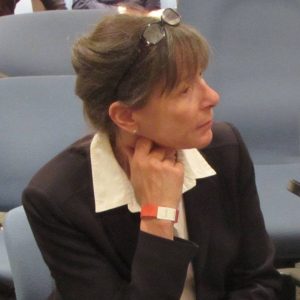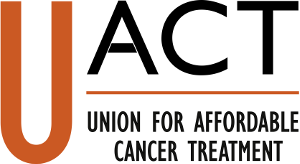ManonRess-UACT-USITC-17Nov2015

Testimony of Manon Ress on behalf of the Union for Affordable Cancer Treatment (UACT)
At the United States International Trade Commission (USITC) hearing on “Economic Impact of Trade Agreements Implemented Under Trade Authorities Procedure, 2016 Report. Inv. No.: 332555
November 17, 2015
The Union for Affordable Cancer Treatment (UACT), is an international network of people who share the conviction that cancer treatment and care should be available everywhere for everyone, regardless of gender, age, nationality, or financial resources. Our web page is
http://cancerunion.org.
We are a union of people people affected by cancer, their family members and friends, people who take care of people with cancer, health care professionals and cancer researchers committed to increasing access to effective cancer treatment and care.
I myself am a stage IV HER2 positive breast cancer patient in active treatment since May 2010. I am extremely fortunate to have access to the most advanced cancer treatment available. Thanks to successful and efficient treatments, my cancer as for many cancer patients has become a chronic disease. It is costly and will be more and more costly for all of us as the price of insurance will increase to keep up with the many cancer patients living for longer and longer time.
We believe that cancer medicines and other essential medical tools, such as diagnostic tests, should be affordable. They are not, and things are getting worse.
Like many patients, caregivers, doctors, insurers… and policymakers, we are extremely concerned about the rapidly escalating cost of cancer medication.
For example, according to one large private payer of health care: the average per cycle cost of cancer drugs in 2014 was almost $18,650. The least expensive 2014 cancer drug is $7,400 every 4 weeks and the most expensive is $89,000 every 6 weeks.
Appendix A to this testimony is a table and a chart based upon data on cancer drug prices compiled by Dr. Peter Bach, based upon a methodology he developed earlier for an article on cancer drug pricing in the New England Journal of Medicine (1 N Engl J Med 2009;360:62633. DOI: 10.1056/NEJMhpr0807774) and recently updated. Dr. Bach calculates the monthly cost of new cancer drugs, at the time of the introduction of the medicine.
We added a calculation of the monthly price as a percentage of the average monthly per capita income, as measured by the Gross National Income (GNI), reported by the World Bank.
As you can see from the table and the graph in the attached paper, the initial prices for cancer drugs have increased sharply, not only in nominal and inflation adjusted terms, but as a percent of average per capita incomes.
Dr. Bach’s data includes 101 cancer drugs put on the market from 1965 to 2008, and of these, just 8 had monthly prices more than average monthly incomes.
However, of the 40 new cancer drugs placed on the market from 2009 to 2014, all 40 had monthly prices higher than average monthly incomes. But it is even worse. 26 of these drugs had monthly prices that were more than twice average monthly incomes.
The median price as a percentage of income was 27 percent for the drugs put on the market from 1965 to 1999, 127 percent for the drugs put on the market from 2000 to 2008, and 231 percent, for the cancer drugs approved from 2009 to 2014. This trend should worry everyone, since everyone is paying the taxes and private insurance premiums.
Managers or private or government insurance programs often respond to high prices by narrowing the allowed uses of the expensive medicines, requiring high patient co-payments,
Rationing is not an acceptable solution, to me, and to the many persons living with cancer, who would benefit from new drugs, including those with excessive prices.
If patients lack access to government or private insurance, one response is to go without, a heartbreaking response for those affected by the cancer. ‘Going without’ should be seen for what it is a form of rationing by ability to pay.
In this regard, UACT has two messages for those shaping trade policy.
First, protect the right of governments to take measures to curb expensive prices for drugs. This includes the measures necessary to facilitate a competitive supply of affordable biologic drugs, and includes addressing, and overcoming when necessary, the barriers to competition such as patents, monopolies on test data, and providing access to manufacturing know how.
In our opinion, when the prices are excessive, it is important to put the monopoly at risk, and not the patients, and trade agreements need to recognize the importance of exceptions to intellectual property rights.
More generally, there has been a failure in all the trade agreements to address the most important issue regarding innovation, and that is the funding of research and development. High drug prices have an impact on R&D spending, but only to induce a minor fraction of drug revenues into R&D. Remember, when a pharmaceutical company spends 15 percent of revenue on R&D, they spend 85 percent on things that have nothing to do with R&D. So high prices is an expensive and harmful way to induce R&D spending.
What all of the trade agreements lack are measures to induce more R&D spending through other mechanisms, such as delinkage from drug prices.
Note that in 2014, 9 of 10 new cancer drugs qualified from the Orphan Drug Tax Credit, a 50 percent subsidy for R&D that only US taxpayers subsidize. The NIH spends more than $30 billion on research, much of it related to new drug development. What trade agreements lack are effective mechanisms or indeed any mechanism to expand public sector funding of R&D, or share the costs of subsidies like the Orphan drug tax credit.
By choosing to focus on intellectual property rights instead of research and development of new drugs, and by effectively promoting high prices instead of innovation and health, trade policy makers are elevating drug company interests over the public, including patients, taxpayers and employers.
